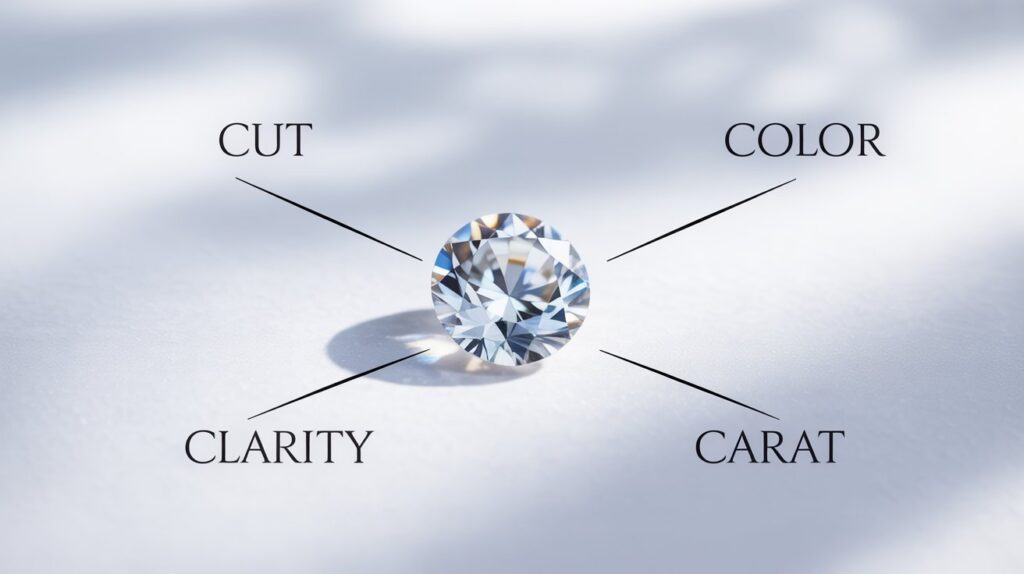Buying a diamond is one of the most exciting and significant purchases many people will ever make. Whether it’s for an engagement ring, a special anniversary, or a personal milestone, a diamond is a powerful symbol of love, commitment, and personal achievement. Yet, the world of diamonds can feel complex and overwhelming.
This guide is designed to empower you with the essential knowledge you need to shop with confidence. We’ll break down the most important factors, moving you from feeling overwhelmed to feeling informed. As experts in both timeless natural diamonds and innovative lab-grown diamonds, we’re here to help you navigate your journey.

The Foundation: Understanding the 4Cs
The 4Cs—Cut, Clarity, Color, and Carat—are the universal standard for evaluating diamond quality. Created by GIA, this system allows you to understand and compare a diamond’s characteristics. Think of it as the language of diamonds.
1. Cut: The Creator of Sparkle
Diamond Cut is often called the most important “C” because it is the only one determined by human skill, and it has the biggest impact on a diamond’s sparkle.
- What it Is: Cut refers to how well a diamond’s facets, proportions, and symmetry have been crafted. It is not the same as the diamond’s shape (e.g., round, princess, oval).
- Why It Matters: A well-cut diamond reflects light beautifully from one facet to another and disperses it back through the top, creating that breathtaking brilliance, fire, and scintillation. A poorly cut diamond will appear dull or lifeless, even if it has high grades in the other 3Cs.
- The Grading: GIA’s cut grade for round brilliant diamonds ranges from Excellent to Poor. Prioritizing Cut is key to getting a diamond with maximum sparkle.
2. Clarity: The Diamond’s Purity
Diamond Clarity measures the presence of tiny, natural characteristics called inclusions (internal flaws) and blemishes (external flaws). Think of these as the diamond’s unique birthmarks.
- What it Is: Clarity is a measure of how free a diamond is from these natural marks.
- Why It Matters: Most inclusions are microscopic and cannot be seen with the naked eye. However, larger or more numerous inclusions can interfere with how light travels through the stone.
- The Grading: The scale ranges from Flawless (FL) to Included (I1, I2, I3). An “eye-clean” diamond is one with inclusions that are not visible to the naked eye. This is a great way to find value.
3. Color: The Diamond’s Natural Tint
For most “white” diamonds, Diamond Color is actually about the absence of color.
- What it Is: This grade measures the degree of yellowness or brownness present in a diamond.
- Why It Matters: The less color a diamond has, the rarer and more valuable it is.
- The Grading: The scale runs from D to Z. D is completely colorless and the most rare. As you move down the alphabet toward Z, the diamond has an increasingly visible yellow tint. Many people find diamonds in the Near Colorless range (G-J) to be a beautiful and more affordable option.
4. Carat: The Diamond’s Weight
Diamond Carat is the measurement of a diamond’s weight, not its size.
- What it Is: One metric carat is equal to 200 milligrams.
- Why It Matters: As all other factors being equal, a larger diamond is rarer and therefore more expensive. However, two diamonds of the same carat weight can have very different values depending on their Cut, Clarity, and Color.
- The Grading: Diamonds are priced on a per-carat basis, and prices can increase exponentially at certain “magic” carat weights (e.g., 1.00 carat).
Beyond the 4Cs: Other Key Factors to Consider
While the 4Cs are the foundation, a few other factors are essential for making a confident purchase:
Certification: Your Guarantee of Quality
A diamond certificate from a reputable, independent gemological lab (such as GIA or IGI) is your guarantee of a diamond’s quality. This report verifies the diamond’s authenticity and provides a detailed breakdown of its 4Cs and other characteristics. Always ask for a certified diamond.
Origin: Natural vs. Lab-Grown
Today, you have two wonderful options when it comes to a diamond’s origin, and the right choice depends on your personal values:
- Natural Diamonds: These are unique, billion-year-old treasures of the Earth. They appeal to those who cherish rarity, tradition, and heritage. Reputable suppliers provide natural diamonds with a clear and ethical origin story.
- Lab-Grown Diamonds: These are scientifically identical diamonds created in a lab. They appeal to those who prioritize value, sustainability, and transparency. Lab-grown diamonds offer a way to get a larger stone for your budget.
Ethical Sourcing: A Story You Can Be Proud Of
Ensuring your diamond has an ethical story is more important than ever. Whether choosing a natural diamond from a responsible source or a lab-grown diamond with a clear origin, a transparent supply chain gives you peace of mind.
Shambh: Your Trusted Partner in the World of Diamonds
Navigating the world of diamonds can feel complex, but you don’t have to do it alone. As a supplier that honors both the timeless beauty of natural diamonds and the innovative elegance of lab-grown diamonds, Shambh is your strategic partner.
We provide a wide range of accurately graded, certified diamonds, and our expert team is here to help you understand the perfect balance of the 4Cs and other factors that will best suit your business needs and your customers’ desires.
Before you buy a diamond, remember to educate yourself from this guide, understand the importance of certification, and consider the diamond’s origin. Armed with this knowledge, you are empowered to make a choice that is not only beautiful and brilliant but also one that you can feel confident about for a lifetime.
Ready to explore a diverse collection of certified diamonds?
Contact Shambh today to discuss your diamond needs and discover the perfect stones for your business.
